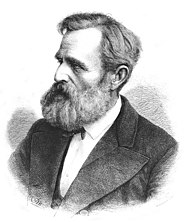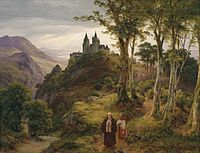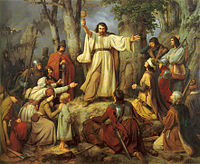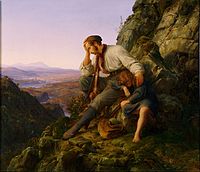Karl Friedrich Lessing
This article needs additional citations for verification. (August 2021) |

Karl Friedrich Lessing (15 February 1808, Breslau – 4 January 1880, Karlsruhe) was a German historical and landscape painter, grandnephew of Gotthold Ephraim Lessing.[1]
Biography[]
His father, also named Karl Friedrich Lessing (1778–1848), was a judicial officer. His mother, Clementine née Schwarz (1783–1821), was the daughter of a government Chancellor for the House of Hatzfeld in Trachenberg. His brother, Christian Friedrich, became a doctor and botanist. His sister, Franziska Maria (1818–1901), married the painter, . He spent most of his childhood in Wartenberg, where he developed an early love of nature.
After spending two years at a Catholic school in Breslau, his talent for drawing was noted by the artist, who, in 1822, arranged for him to study at the Bauakademie in Berlin. The following year, against his father's wishes, he decided to become a painter. He spent three years studying at the Prussian Academy of Arts with the landscape painters and Heinrich Dähling. A successful showing in 1825, with the sale of a painting, reconciled his father to his chosen career. In 1826, he accompanied one of his instructors, Friedrich Wilhelm von Schadow to the Kunstakademie Düsseldorf. There, he became associated with the Düsseldorfer Malerschule. In 1827, he undertook further studies in landscape painting with Johann Wilhelm Schirmer.

In the first phase of his career, he painted dark and imaginative landscapes, after the style of Caspar David Friedrich. Later, Schadow encouraged him to take up history painting and helped him obtain a commission from Count to paint a cycle of frescoes depicting the life of Frederick Barbarossa at . He completed part of a monumental representation of the Battle of Iconium, but decided that wall painting did not appeal to him, and allowed another artist at the project, Hermann Plüddemann, to finish the fresco, from his sketches.
He married Ida Heuser (1817-1880), daughter of the businessman, Heinrich Daniel Theodor Heuser (1767–1848), in 1841. Three of her sisters, Louise Wüste, Adeline Jaeger and Alwine Schroedter, were painters. They had several children, including the painters, and , and the sculptor, Otto Lessing. His daughter, Bertha (1844-1914), married the actor, Karl Koberstein (1836-1899). The painter, Hans Koberstein (1864-1945), was their son.
In 1846, he was offered the position of Director at the Städelschen Kunstinstituts in Frankfurt am Main, but declined. Later, in 1858, he accepted an appointment as Director at the Großherzoglich Badischen Gemäldegalerie in Karlsruhe. There, he resumed painting landscapes. In 1867, he received another offer, as Director of the Kunstakademie Düsseldorf, but chose to remain in Karlsruhe.
Over the course of his career, he was awarded several honors. In 1848, he was named a Professor by King Friedrich Wilhelm IV, and was one of the first artists to receive the Pour le Mérite medal. He was also a member of the Prussian Academy and served as Chairman of the progressive artists' association "Malkasten" (Paintbox).
During his last decade, he suffered several strokes, which left him unable to work. He died of one in 1880, at the age of seventy-two, and was buried in Karlsruhe's main cemetery, with a memorial designed by his son Otto. The cemetery was levelled in 1956.
Selected paintings[]

Romantic Landscape with
Monastery Complex, 1834
The Hussite Sermon,
depicting Hussites
The Last Crusader
Forest Chapel

The Robber and His Child
References[]
- ^ Atkinson, J. Beavington (September 1865). "German Painters of the Modern School. No. VIII.—Karl Friedrich Lessing". The Art Journal: 261–265.
- This article incorporates text from a publication now in the public domain: Gilman, D. C.; Peck, H. T.; Colby, F. M., eds. (1905). . New International Encyclopedia (1st ed.). New York: Dodd, Mead.
Further reading[]
- Friedrich von Weech: Carl Friedrich Lessing. In: Badische Biographien, Part III, G. Braun, Karlsruhe 1881, pp.76–81 (Online).
- Moritz Blanckarts (1883), "Lessing, Carl Friedrich", Allgemeine Deutsche Biographie (ADB) (in German), 18, Leipzig: Duncker & Humblot, pp. 450–453
- Lessing, Karl Friedrich. In: Friedrich von Boetticher: Malerwerke des neunzehnten Jahrhunderts. Beitrag zur Kunstgeschichte, Vol. I, Dresden 1895, pp. 844 ff.
- Vera Leuschner (1985), "Lessing, Carl Friedrich", Neue Deutsche Biographie (in German), 14, Berlin: Duncker & Humblot, pp. 348–349; (full text online)
- Martina Sitt (Ed.): Carl Friedrich Lessing. Romantiker und Rebell. Donat, Bremen 2000, ISBN 3-934836-04-6
External links[]
| Wikimedia Commons has media related to Karl Friedrich Lessing. |
- Literature by and about Karl Friedrich Lessing in the German National Library catalogue
- 1808 births
- 1880 deaths
- 19th-century German painters
- 19th-century male artists
- 19th-century painters of historical subjects
- German male painters
- People from the Province of Silesia
- Artists from Wrocław
- Prussian Academy of Arts alumni
- Recipients of the Pour le Mérite (civil class)




